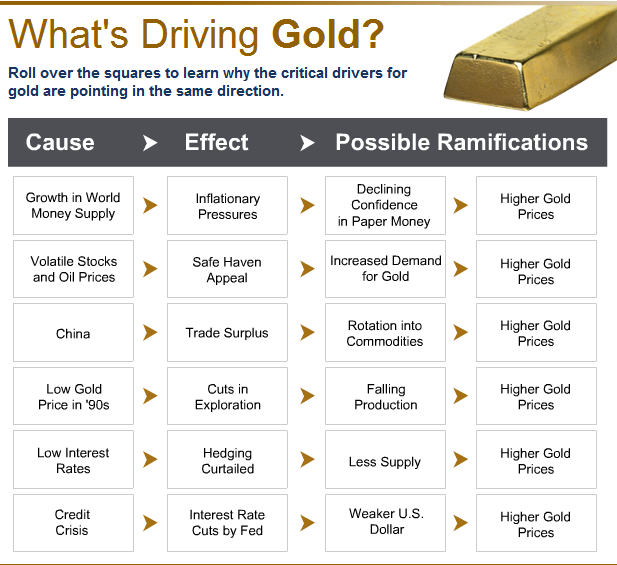| BCA Research: gold bull market will continue in 2011 - Barry Sergeant - MineWeb |  |  |  |
JOHANNESBURG -
For many years, "gold bugs", a rare but widely scattered species, have led the charge in preaching the irresistible advantages of owning gold bullion, above all else, except for more gold bullion. As in the case of most commodities, the price of gold bullion has been on the rip, broadly speaking, for nearly a decade, rising nearly six fold to recent all time highs of just over USD 1,431/oz.
But in percentage terms, much the same can be said for most commodities. The past decade has been characterised by ferocious increases in demand for raw materials from developing nations, and a protracted bear market for the dollar. During the 2008 credit market crisis, however, gold bullion fell less (in percentage terms) than other commodities.
The apparent extra sheen that gold offers some investors tends to heighten the possibility - in the eyes of the same investors - that the metal's price could rise infinitely. Senseless as the idea may seem, it has created endless debate over such a possibility. For doubters, the Bank Credit Analyst, a (thankfully) independent, Canada-based, research group, has published an update on the outlook for the yellow metal, and concludes with the hands-on notion that "the gold bull market will continue in 2011".
The gold bull market, BCA Research argues, "has been driven by the potential inflationary implications of current large fiscal deficits and central banks that are prepared to stop at nothing to prevent deflation.
"It may be several years before developed-world real interest rates return to the norms of earlier decades, especially in the US. In this environment, gold will continue to be an excellent insurance policy and should continue to fare well when measured against the major currencies".
Short-term interest rates in the developed world are at historic lows - below 1%, for instance, in the US, Japan, Britain and Canada, and just above 1% across the Eurozone.
In his launch essay for 2011, Bill Gross, MD of PIMCO, the world's biggest bond fund, based in the US, argues that "one of the consequences of perpetual trillion dollar deficits is the need to finance them, and at attractively low interest rates for as long as possible".
Gross says that annual (US) budget deficits in the trillions of dollars "add a like amount to the stock of outstanding dollars, resulting in currency depreciation, higher import inflation, and a degradation of dollar based assets in global financial markets. We become less, not more wealthy, losing our heads while we ‘hold on firmly and go on with (our) business'!"
The reference to dollar based assets has particular implications for commodities, given that most are quoted, and traded, in dollars. Thus the six fold increase in gold bullion prices over the past decade, which refers to dollar prices, will necessarily translate to different returns in other currencies. Returns for dollar gold bullion have not matched, for instance, those measured in yen or Euros.

Currently, the Federal Reserve, the US central bank, is both holding short term interest rates near zero, and, as Gross puts it, "engaging in Ponzi like Quantitative Easing II purchases of longer dated Treasuries in the open market". The combination, argues Gross, "offers bondholders about as an attractive situation as the one facing a male praying mantis: zero percent interest rates if you stay in cash, or probable principal losses if you take durational risk by buying 5 and 10 year maturities".
Eventually, as reflationary policies take hold, long-term bondholders, as Gross puts it, "lose their heads (and a portion of their principal as well), as yields rise to reflect higher future inflation. Bondholders' metaphorical warning: don't go near those longer term bonds you fool'."
Back to gold bullion, BCA Research argues that it is hard to make the case that gold is currently "a crowded trade". Many institutional and retail investors agree with the gold bull case but have been slow to act, argues BCA Research, "even as their faith in conventional stocks and bonds has ebbed. Indeed, based on investor meetings and anecdotal evidence, we estimate that the average portfolio allocation to gold is around 1%.
"This suggests that there is plenty of pent-up demand which could still flow into gold and related shares. True, the gold bull market will proceed in installments, not a straight line. It would not be a surprise to see gold suffer occasional selloffs of perhaps a few hundred dollars at a time during 2011.
"We would broadly view these selloffs as opportunities to boost core holdings. The bottom line is that gold is a potential mania candidate and expect good returns in this metal in 2011".
Source: http://www.mineweb.com/mineweb/view/mineweb/en/page33?oid=117892&sn=Detail&pid=102055






